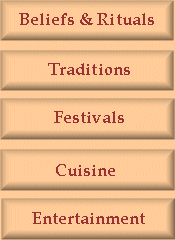


India, the vibrant land of mythological tales, of Gods and Goddesses and a thousand beliefs, has evolved over centuries as a mystic land of festivals.
Every occasion you can dream of is celebrated with gaiety, pomp and fervour. These colourful and happy festivals bind the people of the nation across various states and religions in a unique way and provide a spectacle that cannot be be experienced anywhere else in the world.
The most popular festivals of Bengal are: Saraswati Puja - worship of the Goddess of
learning, Durga Puja - worship of the divine Mother, Lakshmi Puja - worship of the Goddess of wealth, Dol - the festival of colors and a celebration of the triumph of good over the evil, Kali Puja - the worship of the Goddess of destroyer of evils, Bhai Phota - the special day for brothers, on which the sister prays for the brotherís safety, success and well-being.The greatest social and religious event of the Bengali calender is Durga Puja, a festival in October given over to theworship of the Mother Goddess.
The shops do brisk business; it is estimated that nearly half of all clothing bought by Bengalis during the year is bought during these few days. Each locality in Bengal has its own statue, built to specification, of Durga, the benign smiling Mother Goddess, and there is great competition between the different paras or localities, each striving to have the brightest and best statue. With a great flurry of firecrackers and beating of drums, Goddess Durga is borne to her pedestal to be watched, admired and worshipped for five days by passing humanity.
These five days are filled with ceaseless activity-social, cultural and religious. Bengali women wear beautiful new sarees and offer flowers and sweets to the Goddess and also smear vermillion on their faces as a ritual. At the end of the five holy days, the statue of Goddess Durga is borne away to the Mother Ganges, mother of the world, tossed into the waters and delivered unto her. Thus the Bengali voyage begins again through the travails of the coming year to yet another Durga Puja.
Another important festival is Kali Puja, a festival in which people worship Goddess Kali, the goddess of destruction, the saviour of mankind from evil demons. During this Puja, clay images of demons are sold to be placed alongside images of Kali herself. At the end of festivals, thousands of devotees converge on Babu Ghat, Outram Ghat and Princep Ghat in Calcutta to immerse clay images of Durga, Kali, Lakshmi and Saraswati into the river. Every year, in mid-January, a religious festival, Gangasagar Mela is celebrated at Sagardwip, the last island before the ocean, where the Ganga meets the sea. Over half a million pilgrims take a holy dip and then converge at the Kapil Muni temple.
Bengalis have their own New Yearís day, called Poila Boishakh, on the 14th of April. On this day, people wear new clothes, special dishes are cooked at home and various cultural programmes are held all over the state. Boishakh is the first month of Bengali calendar. It ushers the beginning of agricultural production of Bengal. Though over the years English calendar has gained precedence, most of the events in the villages takes place according to the Bengali calendar.
